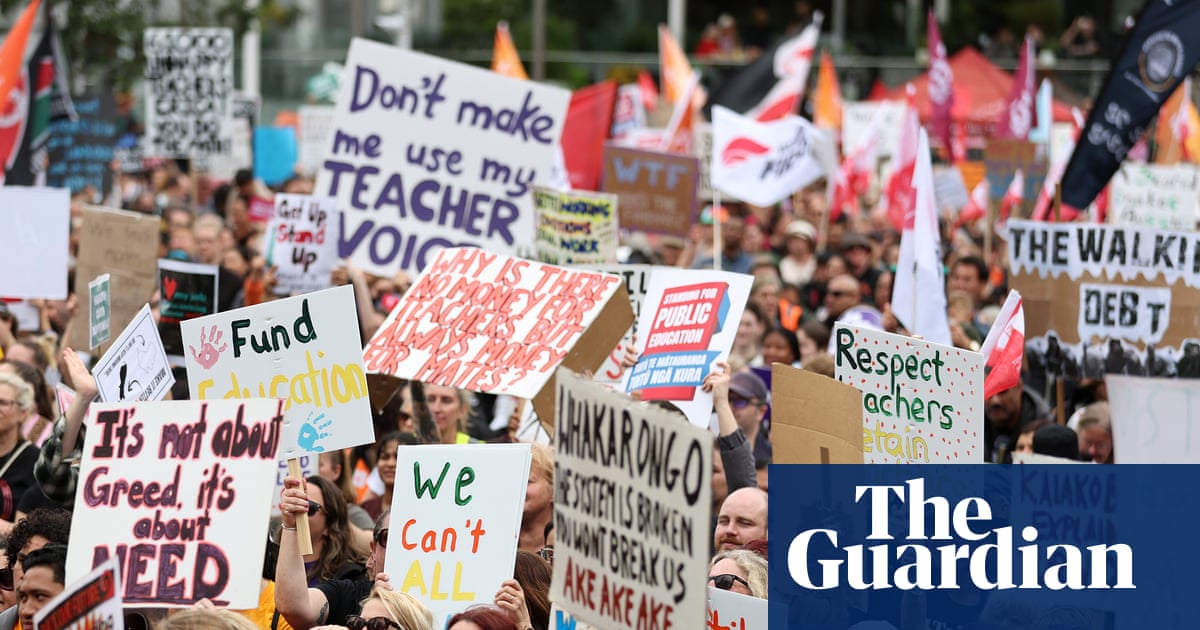An estimated 100,000 nurses, teachers and public sector staff walked off the job in New Zealand on Thursday to call on the government to better fund and resource public services, in one of the country’s largest ever strikes.
The so-called “mega strike” brought together workers from multiple sectors, including more than 60,000 school teachers, 40,000 nurses and salaried medical specialists and 15,000 public service staff.
Despite extreme weather forcing the cancellation of events in Wellington and other regions, tens of thousands gathered at rallies across the country, where they held signs, chanted and demanded the government invest in education and health.
“Patients should not have to be harmed, or die, before things improve,” Becks Kelsey, a nurse, told a rally in Auckland.
“We demand the government invests in the very fabric of our community, not cut the threads that hold it together.”
Secondary school teacher Paul Stevens told the rally teachers were leaving the profession and country they love “because they have just had enough and they don’t feel valued”.
“We need our politicians to do their job and to acknowledge the political choices they have made, over the success of governments, to gradually starve our essential public services of what they need.”
Allow content provided by a third party?
This article includes content hosted on embed.bsky.app. We ask for your permission before anything is loaded, as the provider may be using cookies and other technologies. To view this content, click ‘Allow and continue’.
Members from multiple unions voted to strike after collective bargaining with the coalition government stalled. While each union has demands specific to their sector, the complaints were broadly consistent: inadequate pay, unsafe staffing levels, not enough resources, and poor working conditions that put the wellbeing of workers, patients and children at risk.
“We fear for the safety of our patients,” Noreen McCallan, a nurse in Hawke’s Bay, said in a statement. “Staff shortages have become overwhelming and exhausting for many of us. Our patients are suffering longer because we can’t get to them as quickly as we should.”
A teacher in Palmerston North, Liam Rutherford, said there needed to be “serious investment in education, not just tinkering around the edges”.
“The current offer from the government won’t help us in recruiting new teachers and keeping the ones we currently have. The pull of Australia is too much.”
Education and healthcare workers and others rally in Auckland during the strike, one of New Zealand’s largest ever. Photograph: Fiona Goodall/Getty Images
New Zealand’s health and education services have come under increasing pressure in recent years. Hospitals have reported facing “catastrophic failure” due to being over capacity, lengthy wait times for care and staff shortages. Schools are also facing staffing shortfalls.
At the same time, the government has slashed funding for public services in its hope to grow the economy and cancelled dozens of pay equity claims.
Meanwhile, citizens are leaving the country in record numbers, the majority of whom are moving to Australia for more job opportunities and better pay, including in education and healthcare.
Today’s planned strikes are unnecessary and politically motivated by the unions. Workers’ pay claims will only be settled by negotiation, and the Government is ready to talk.
— NZ National Party (@NZNationalParty) October 22, 2025
The coalition government has been hostile towards the protest, with the prime minister, Christopher Luxon, dismissing it as “politically motivated” and senior ministers for education, health and public services calling it “unfair, unnecessary and unproductive”.
The government was “at the table with offers” while the unions were “out on the street with megaphones”, the public service minister, Judith Collins, said in a statement.
She said the strike was a “a stunt” targeting government, in which thousands of patients and children would pay the price.
Many schools closed on Thursday due to the strike, while heath providers reduced non-essential services. Despite the disruptions, public support for the strike is favourable. A Talbot Mills poll suggested 65% of the public backed the strike, and nearly half of those who voted for the coalition government were also in favour.
Opposition parties backed the strike, with the Labour leader, Chris Hipkins, laying responsibility for the industrial action on the prime minister.
“Luxon is out of touch and making our health and education systems worse,” Hipkins said in a statement.
“He has made his priorities clear: handing out massive pay rises to boardroom directors and millions to tobacco companies, instead of investing in the services we all rely on.”

